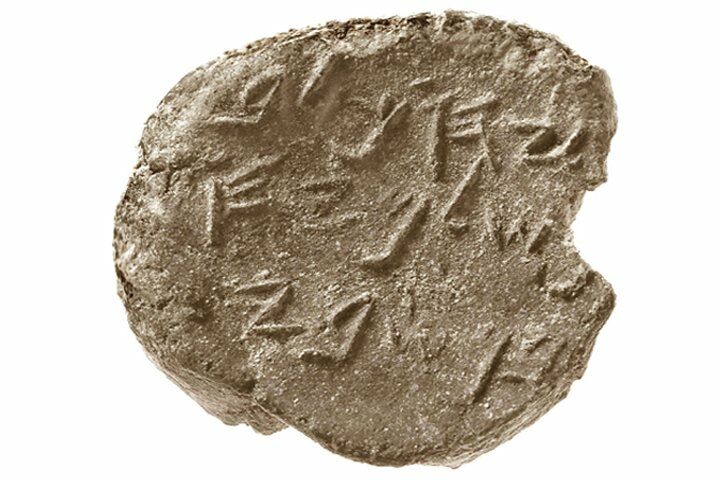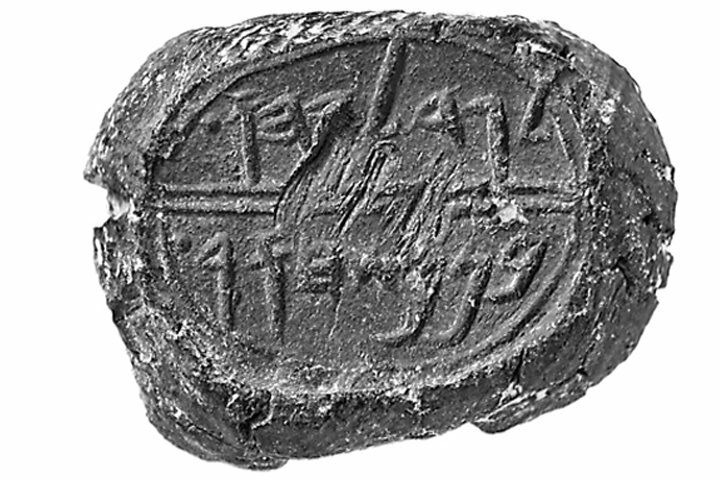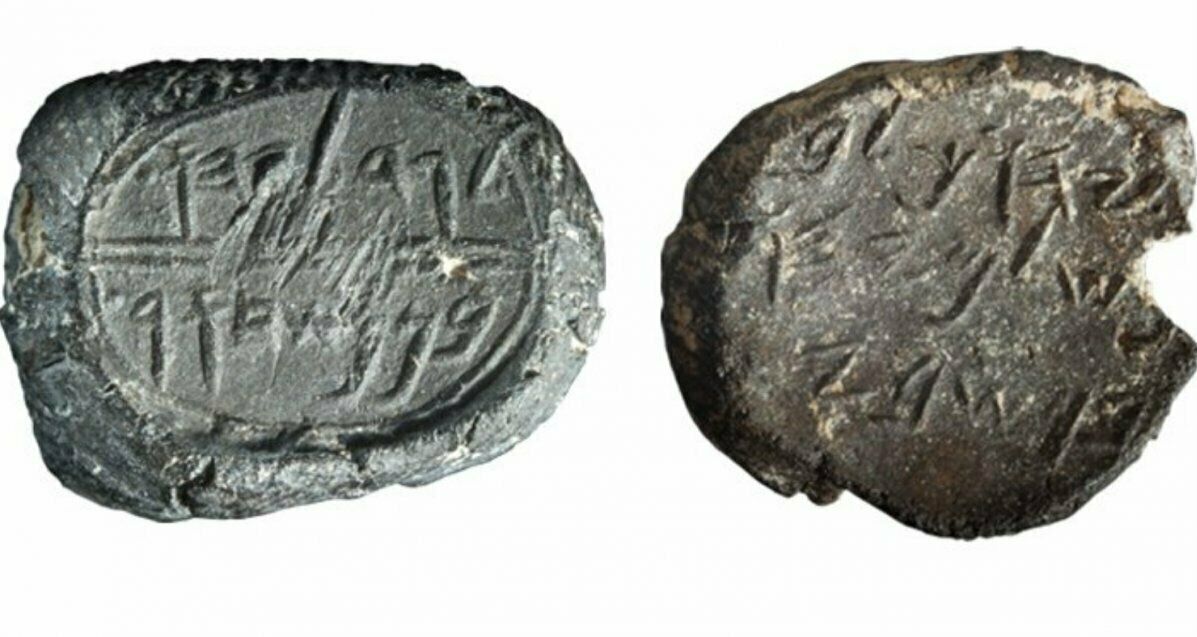I took the bulla home that night. Well into the night, when the children were asleep and the house was quiet, I began to study it. Slowly, I deciphered the name in the first line: Yehuchal. Could it be a Biblical name? I did not recall any Yehuchal in the Bible. Perhaps my reading of the name was wrong. But just to make sure I pulled from the shelf a Biblical encyclopedia. There he was, as large as life—in the book of the prophet Jeremiah: King Zedekiah sent Yehuchal (Jehucal in English Bibles) son of Shelemiah to the prophet Jeremiah … When I opened the encyclopedia and saw the same name in the Bible as was on the bulla, I let out a shriek of surprise that rang out through the still house. Fortunately, the children slept soundly. I felt as though I had just “resurrected” someone straight out of the Bible. (Dr. Eilat Mazar, Did I Find King David’s Palace? bar)
The above account was that of leading Jerusalem archaeologist, Dr. Eilat Mazar, after her 2005 excavation efforts in the City of David revealed a bulla (a clay stamp used for sealing documents) bearing the words “Belonging to Jehucal, son of Shelemiah, son of Shovi.” Jehucal, son of Shelemiah, was an important prince who featured in the book of Jeremiah, chapters 37 and 38. Just two years later, she discovered another bulla—this one belonging to a fellow prince of Jehucal’s, also mentioned in Jeremiah 38. This bulla read: “Belonging to Gedaliah, son of Pashur.” Both bullae date to the same time period as their biblical counterparts.
This is the remarkable story of two leading biblical princes—archenemies of the prophet Jeremiah—brought to life through archaeology.
The Bullae: Jehucal

Measuring just one centimeter in diameter, this tiny bulla was nearly missed by the excavators. As Mazar continued to write, “The credit for its discovery goes to the hawk eyes of Yoav Farhi, the supervisor of our Area A. He spotted it at the exact moment when the sun’s rays illuminated the letters. Without this particular lighting, you can see nothing. Even when the bulla is lit from various directions, only letter fragments are visible. Lighting from a certain specific direction, however, suddenly illuminates all of the letters as if by magic.” This bulla has no ornamentation or embellishments—unsurprising, considering the lower rank of the individual to whom it belonged.
As Dr. Mazar described, she took the bulla home that night to decipher it. She notes that it was a rather special moment: In order to read the ancient script, she used a lexicon that had been compiled by her late husband. She brought together her children, and showed them how she used his compilation to compare and translate the Hebrew text.

The reading was clear. “Belonging to Jehucal, son of Shelemiah, son of Shovi.” The Bible describes that this Jehucal was a prince sent to the prophet Jeremiah to ask him to pray for the people of Jerusalem (Jeremiah 37:3). He also was part of the cabal of princes that called for the death of Jeremiah (38:1-6). After king Zedekiah turned Jeremiah over to the princes, they threw the prophet into a miry pit, where he would have died were it not for the efforts of the Ethiopian servant Ebed-melech.
While the Jehucal bulla is significant in that it describes two biblical figures—Jehucal and Shelemiah—it is also notable in that it provides a third generation. This is extremely rare, as bullae usually only list two generations. Evidently, Jehucal’s grandfather, Shovi, must have been a significant governmental official, one that would have been on the scene during the reign of the venerated king Josiah.
The Bullae: Gedaliah

In December of 2007, another bulla was discovered during Dr. Mazar’s excavations through a process known as “wet sifting.” This method provides a far higher success rate for finding small items than the usual dry sifting. Dr. Mazar was the first archaeologist to incorporate this new method into excavations.
The text on this bulla reads “Belonging to Gedaliah, son of Pashur.” Slightly larger than the Jehucal bulla, the Gedaliah bulla contains more embellishment—indicating that this was a prince on a somewhat higher level. This bulla contains a fingerprint on it, likely of the very prince himself. Gedaliah is mentioned together with Jehucal in Jeremiah 38:1-6 as having called for the execution of Jeremiah, before summarily throwing him into the dungeon.
His father, Pashur, is mentioned in verse one, and may be the same Pashur recorded in Jeremiah 20. This man was the chief governor in the temple, and the son of a priest. He physically attacked the prophet Jeremiah, and had him put in stocks near the Temple. For these actions, a terrible curse was pronounced on Pashur. He was renamed by God as “Magor-missabib,” or “terror on every side,” and was condemned, with his friends, to die in Babylon.
Interestingly, it is just after this persecution from Pashur that Jeremiah writes of a period of deep depression and a desire to give up on his commission (20:7-18). However, this period didn’t last long. “But His word was in my heart like a burning fire, shut up in my bones; I was weary of holding it back, and I could not” (verse 9, New King James Version).
If this Pashur was indeed the father of Gedaliah, it would certainly add deeper context to the violent animosity his son Gedaliah held towards Jeremiah.
The “House of Bullae”
The bullae belonging to Jehucal and Gedaliah were found in and around the Large Stone Structure, identified by Dr. Mazar as the Palace of King David. This building originally dates to the period of King David (10th century b.c.e.), and evidently continued to be used as an administrative area up to the c. 585 b.c.e. destruction of Jerusalem (these bullae dating to the years just prior to this destruction). The bullae help show the royal administrative nature of this building. And they are not the only pieces of scribal evidence for this.
Just below the palace, near the base of what is known as the “Stepped Stone Structure,” a house was discovered during excavations by Yigal Shiloh. This building was found to be full of bullae—45 in total—and came to be known as the “House of Bullae.” Evidently, this was a significant administrative/scribal building for processing royal documents. Of all the bulla discovered during his investigations (mainly during the 1980s), one stands out: that of Gemariah, son of Shaphan.
Gemariah is mentioned (alongside his father Shaphan) in Jeremiah 36. Compared to the princes Gedaliah and Jehucal, Gemariah is a breath of fresh air. Just before Zedekiah took the throne (during the reign of King Jehoiakim), Gemariah was a scribe who served in a chamber at the entrance to the Temple. He and his fellows called on Baruch to read Jeremiah’s new scroll to them, and they were so sobered by the contents that they took it to the king, urging Baruch and Jeremiah to hide themselves for their safety. As the grave message was read out to Jehoiakim, the king suddenly leapt out of his chair, slashed up the document, and threw it into a fireplace. Gemariah was one of the officials that pleaded for the king to stop—to no avail. It wasn’t long after this that the Babylonians began the first of their three invasions, subjugating the Kingdom of Judah.
The Big Picture: Jeremiah’s Warning to Judah
The prophet Jeremiah began warning Judah during the 13th year of King Josiah’s reign, around 627 b.c.e. His warning intensified during the reigns of Jehoiakim, Jehoiachin, and chiefly that of Judah’s last monarch, King Zedekiah. Jeremiah’s message was consistent and inescapably clear: He warned that God was raising up the Babylonian Empire to punish Judah for its idolatrous ways.
The third chapter of the book of Jeremiah details the prophet beseeching Judah to learn from the example of the nation of Israel, which had gone into Assyrian captivity around a hundred years earlier. Despite that horrific and fairly recent history, “treacherous Judah her sister feared not; but she also went and played the harlot” (Jeremiah 3:8).
By 604 b.c.e., Jeremiah had been warning Judah for 23 years. Exasperated but unwavering, he told King Jehoiakim that, since Judah had rejected the warnings, God would send “Nebuchadrezzar the king of Babylon … and will bring [him] against this land, and against the inhabitants thereof, and against all these nations round about; and I will utterly destroy them …” (Jeremiah 25:8-9). Jehoiakim did not listen to Jeremiah’s message, and in 604 b.c.e. Nebuchadnezzar conquered Judah, taking control of the land and turning Jehoiakim into a puppet king.
In 597 b.c.e., due to a rebellion by Jehoiakim, Nebuchadnezzar besieged Jerusalem. He captured Jehoiakim, installed Zedekiah as a puppet king and made him swear an oath of loyalty to Babylon (2 Chronicles 36:13).
Initially, Zedekiah was subservient to Babylon and civil to Jeremiah. But in his fourth year as king, Judah’s desire for independence from Babylon grew strong. Jeremiah warned Zedekiah that Nebuchadnezzar would only return and utterly destroy Jerusalem. Again, the ruling class stubbornly ignored God’s warning through Jeremiah, and c. 587 b.c.e., Nebuchadnezzar marched on Jerusalem once again. Jeremiah continued to warn that Judah would not escape the grip of the Babylonians, and that any resistance was futile. Though his message was grim, the prophet also told the people of Judah that there was a way to escape. The way to survive, he explained, was to surrender and submit to King Nebuchadnezzar and the Babylonians.
On one occasion, Jeremiah told King Zedekiah to “Bring your necks under the yoke of the king of Babylon, and serve him and his people, and live“ (Jeremiah 27:12). He repeatedly relayed God’s word that the people could even thrive in Babylonian captivity.
Sadly, Jeremiah’s warnings continued to go unheeded by Judah’s rulers, priests and people. Rather than turning many to safety, Jeremiah’s brave, faith-filled work almost got him killed.
Jeremiah vs. Judah’s Nobility
Jeremiah’s message was unpopular throughout Judah, but no group was as infuriated by it as the nation’s patriotic but faithless elite.
The Judeans were insulted at the prophet’s warnings, and some powerful men plotted against him: “Come, and let us devise devices against Jeremiah; For instruction shall not perish from the priest, Nor counsel from the wise, nor the word from the prophet. Come, and let us smite him with the tongue, And let us not give heed to any of his words.” (Jeremiah 18:18).
During Zedekiah’s 11-year reign, Judah’s nobles and false priests waged a campaign of slander against Jeremiah to undermine his message and intimidate him into silence. Over the prophet’s four decades of warning Judah, Jeremiah was routinely scoffed at and maligned, severely beaten and even imprisoned.
As Jerusalem’s inevitable destruction drew nearer, the tension between Jeremiah and the royal officials intensified. This titanic battle between Jeremiah and Judah’s officials is recorded in Jeremiah 38.
This momentous chapter has been brought to life by Dr. Mazar’s landmark discoveries of the Jehucal and Gedaliah bullae.
The chapter describes a cabal of ambitious members of King Zedekiah’s court confronting the Prophet Jeremiah. Verse 1 recalls that among this band of tormentors were “Gedaliah the son of Pashur, and Jucal [Jehucal] the son of Shelemiah.”
Both these men were high-ranking officials in Zedekiah’s court, which explains why each had his own distinct seal impression. Jeremiah’s message—that only those who surrendered to the Babylonians would live—infuriated the princes. Gedaliah and Jehucal, along with their cohorts, came before Zedekiah and accused Jeremiah of sedition, saying the prophet’s message was discouraging Judah’s soldiers and other residents: “Let this man, we pray thee, be put to death; forasmuch as he weakeneth the hands of the men of war …” (verse 4).
Zedekiah, whose habitual compromising had robbed him of all confidence in his power, capitulated. Thus, with the king’s consent, the princes “took … Jeremiah, and cast him into the pit … that was in the court of the guard: and they let down Jeremiah with cords. And in the pit there was no water, but mire: and Jeremiah sank in the mire” (verse 6).
This was likely a cistern, designed to collect water during the rainy season to be consumed during the dry summers. At this time, though, it was filled not with water but with thick mud and filth. The prophet sank deep into it, gasping for air as the weight of the mud against his chest made it hard for him to breathe. Here Gedaliah, Jehucal, and the other princes hoped to end Jeremiah’s life and silence his warnings—without having his blood directly on anyone’s hands.
The clash between Jeremiah and the princes would have ended there, with the prophet suffocating in a hole, were it not for divine intervention.
A eunuch in Zedekiah’s service, an Ethiopian named Ebedmelech, learned of the princes’ actions. Risking his life, this brave man went before Zedekiah and pleaded on Jeremiah’s behalf. With Zedekiah’s approval, Ebedmelech orchestrated a 30-man rescue effort to extricate Jeremiah from the mire. The loyal eunuch and his men gathered old clothes, bound them together to make a rope, and then heaved the starving, filthy, faith-filled prophet from the dungeon.
Jeremiah was returned to the palace prison, where he continued to trumpet God’s warning message to Judah in the final months before Jerusalem’s destruction.
A Warning On Display
The first place these two bullae were displayed to the public was at our facilities in Edmond, Oklahoma. Dr. Mazar agreed that our fine arts center, Armstrong Auditorium, would be an appropriate place to exhibit these amazing archaeological finds, and the Israel Antiquities Authority approved. The “Seals of Jeremiah’s Captors Discovered” exhibit was visited by more than 4,000 visitors, and many thousands more concert-goers who visited Armstrong Auditorium during the three year loan of the artifacts. You can view the online exhibit here, as well as the online form of our current exhibit “Seals of Isaiah and King Hezekiah Discovered” here.
The accuracy of the Bible is a long disputed topic. The general bias throughout the archaeological world is to disregard the Bible as a historical source. However, with more and more mounting evidence, those who successfully use the Bible to direct their studies are being thrust more and more into the limelight. Dr. Eilat Mazar is one such archaeologist.
Her finds over the last few decades have added more weight to the accuracy of the biblical account. These two officials were long forgotten even as Jeremiah lived on in apparent legend. Now, with their discovery, the full story of Jeremiah is being brought back into its rightful place as historical reality. For more information about the life and times of the prophet, backed up by many more archaeological discoveries, read our article Jeremiah: The True Story of the “Weeping Prophet.”
